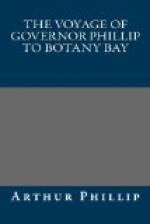At three in the morning, on Sunday August 3, land was discovered bearing from north-north-east to north-west, on which the ships stood off again with a light air of wind. At six, the land in sight appeared like several islands, and an endeavour was made to pass between them to the north, but on approaching sufficiently near, it was discovered that all these points were joined together by a low neck of land covered with trees. As the land rose in nine roundish points, which seamen call hummocks, this place was named Nine Hummock Bay. At noon on this day, the ship then standing to the south-west, in latitude 8 deg.. 55’. south, and longitude 158 deg.. 14’. east, the extreme points of land bore from east by north to west, when Lieutenant Shortland named the western point Cape Nepean, and the eastern Cape Pitt. The intermediate land may, he says, easily be known by the nine hummocks, and the exact resemblance they bear to islands when seen from the distance of five or six leagues. They had now light airs and calm weather, but at two in the afternoon a breeze sprung up from the eastward, and at four Cape Nepean bore north-west, half west, distant five or six leagues. At six the Alexander shortened sail, and stood off and on for the night under double reefed top-sails, Lieutenant Shortland imagining that he had reached the utmost extent of this land. At five, on Monday morning, the 4th of August, he made sail again, and at six a bluff point of the island bore north-north-west, distant five or six leagues: this he called Point Pleasant. At noon the latitude was by observation 8 deg.. 54’. south, the longitude 154 deg.. 44’. east. Point Pleasant then bore east by north; at four, the most western point of land in sight, which was then supposed to be the extreme point of the island, but proved not to be so, bore north-west by north, distant four or five leagues. From this mistake it was named Cape Deception.
Under the persuasion that he had reached the extremity of the land, but desirous to ascertain that point, Lieutenant Shortland kept the ships standing under an easy sail all night. Some islands lying close to Cape Deception, and seeming to form a good harbour, were called Hammond’s Isles. At day light on the 5th of August, land was again discovered, bearing from east north-east to west by north half north, and forming a very deep bay. This land appeared in six hummocks, like islands, but was joined by a low neck of sand. Not knowing how far it might trend to the north-west, Lieutenant Shortland stood out to the south. At eleven o’clock, the longitude was observed to be 157 deg. 30’ east; and at noon the latitude was also determined by observation to be 8 deg. 44’ south. At the same time, Cape Deception bore north-east four or five leagues distant; and two remarkable hills, from their similiarity called the Two Brothers, forming the most western point then in view, bore north-west half north, distant ten leagues. At three in the afternoon, they bore away for the two Brothers, which at six bore north-west by north, distant seven leagues. At eight, the ships lay to for the night.




